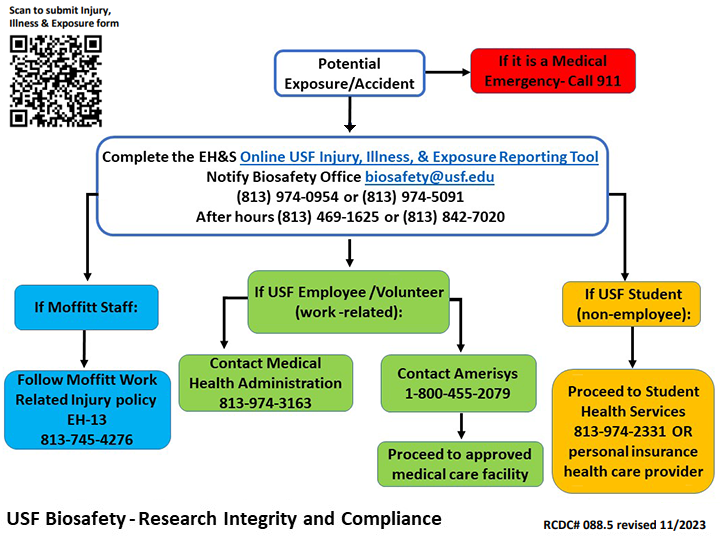Safety & Security
Exposures & Incidents
Response to Exposure/Accident, Bloodborne Pathogens (BBP) for Laboratories Working with Biohazards
Exposures to:
Infectious/biohazardous agents used in research/teaching labs include microorganisms, viruses, recombinant or synthetic nucleic acid molecules, biological toxins and other biohazardous materials that may be capable causing disease, adverse health effects or contamination.
Exposures to biohazardous materials include the following:
- Needle-sticks or other percutaneous injuries from a contaminated sharp
- Splashes to mucous membranes (eyes, nose, mouth)
- Inhalation of aerosolized material (large spill outside of a biosafety cabinet, centrifuge tube malfunction, etc.)
- Contact with open wounds, scratches, cuts
- Bites or scratches from infected animals
Accidents include the following:
- Release of BSL-2 or BSL-3 agent from its primary containment/equipment malfunction
- Environmental release such as a spill (for spill response)
- Theft/loss of infectious agents/rDNA materials
- Escape of infected or transgenic animals
The following emergency response procedures shall be followed when a worker has been potentially exposed to infectious agents including bloodborne pathogens via a needle-stick, cut, infected animal bite, or scratch, via mucous membrane contact, or via non-intact skin contact to ensure prompt and appropriate care. Some post-exposure treatments must be started within 1-2 hours of exposure so time is critical.
Immediate response:
The exposed site must be washed immediately for 10 minutes with copious amounts of water.
- Remove any contaminated clothing.
- If needle-stick, cut, animal bite or scratch, wash with soap and water after allowing the wound to bleed freely. Apply an appropriate skin disinfectant if applicable.
- If mucous membrane (eyes, nose, mouth) flush with water at the nearest faucet or eye wash station for at least 15 minutes.
- If skin contact (intact or non-intact) wash with soap and water. Apply an appropriate skin disinfectant if applicable.
- Seek medical attention, no matter how seemingly insignificant they injury may seem.
Reporting:
All Personnel:
- For medical emergencies call 911.
- Complete the EH&S Online USF Injury, Illness, & Exposure Reporting Tool. This will walk you through the exposure/injury response.
- Notify Biosafety officer (813) 974-0954 (After hours (813) 469-1625) or Biosafety manager (813) 974-5091 (After hours (813) 842-7020) or biosafety@usf.edu the same day as the potential exposure.
USF Employee/Volunteer (work-related):
- The supervisor (with the employee), immediately contact workers compensation at (800) 455-2079. In case of emergency, call as soon as practicable. For information on USF worker’s compensation.
- Proceed to approved medical care facility for initial care.
- Contact Medical Health Administration Health (Employee Health) office at (813) 974-3163 or pager (813) 216-0153.
USF Student (non-employee):
- Proceed to Student Health Services for initial care: Tampa Campus (813-974-2331), St Pete Campus (727-873-4422), Sarasota-Manatee (941-487-4254 OR Personal insurance health care provider.
- Contact Medical Health Administration Health office at (813) 974-3163 or pager (813) 216‑0153.
Moffitt Staff:
- Follow Moffitt Incidents Website per Moffitt Work Related Injury policy EH-13. (813) 745‑4276.
How to Report a Potential Exposure/Accident involving an Infectious/Biohazardous Agent
Accident/Incident Investigation:
The goal of an accident investigation is to determine the causal factors surrounding the incident and recommendation of corrective actions to prevent similar occurrences. Investigators avoid emphasis on assigning blame for the accident, as this threatens the credibility and effectiveness of the accident investigation process. The Overall goal is to promote safe practices and to protect the researchers from exposure/hazards and to mitigate as much as possible.
When reporting to the Biosafety Office be sure to include:
- Description of the incident
- Organism(s) involved
- PPE worn at time of incident
- Cause of the incident (e.g., protocol breach)
- Solution to prevent similar future events
Blood Borne Pathogens
- Notify Biosafety officer (813) 974-0954 (After hours (813) 469-1625) or biosafety@usf.edu the same day as the potential exposure.
- For all USF Health faculty, staff and students, if exposed to a blood borne pathogen contact the USF Health Medical Health Administration Office at (813) 974-3163 or
by pager at (813) 216-0153 during regular working hours. Contact the "on-call" Infectious
Disease Physician at (813) 974-2201 after-hours and on weekends. See website USF Health Bloodborne Pathogens Exposure Control Plan.
- All USF faculty, staff and volunteers who have the potential for occupational exposure to blood borne pathogens with the exception of employees, faculty, staff and volunteers at USF Health must comply with the "USF Bloodborne Pathogens policy 6-031." (PDF)
Exposure Resources:
- How to Report a Potential Exposure/Accident involving an Infectious/Biohazardous Agent (PDF)
- Response to Exposure/Accident, Bloodborne Pathogens (BBP) for Laboratories Working with Biohazards (PDF)
For more information/questions contact the Biosafety office.
